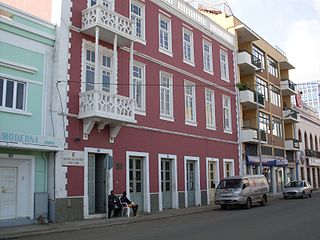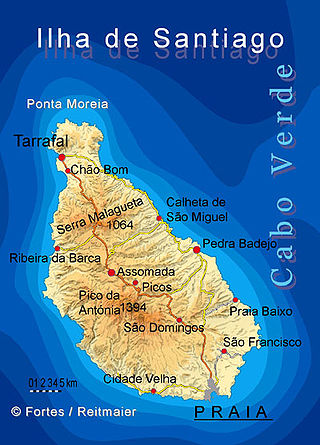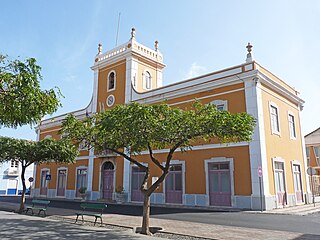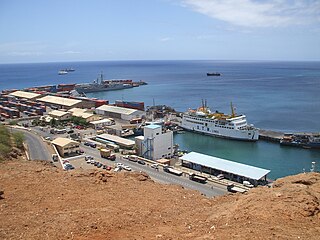| |||||
| Decades: | |||||
|---|---|---|---|---|---|
| See also: | |||||
The following lists events that happened during 1952 in Cape Verde .
| |||||
| Decades: | |||||
|---|---|---|---|---|---|
| See also: | |||||
The following lists events that happened during 1952 in Cape Verde .

The recorded history of Cape Verde begins with the Portuguese invasion and colonization of the island in 1458. Possible early references to Cape Verde date back at least 2,000 years.

Praia is the capital and largest city of Cape Verde. Located on the southern coast of Santiago island, within the Sotavento Islands group, the city is the seat of the Praia Municipality. Praia is the political, economic and cultural center of Cape Verde.

Cape Verde is known internationally for morna, a form of folk music usually sung in the Cape Verdean Creole, accompanied by clarinet, violin, guitar and cavaquinho. Funaná, Coladeira, Batuque and Cabo love are other musical forms.

São Tomé is the capital and largest city of the Central African island country of São Tomé and Príncipe. Its name is Portuguese for "Saint Thomas". Founded in the 15th century, it is one of Africa's oldest colonial cities.
The International Portuguese Language Institute is the Community of Portuguese Language Countries's institute supporting the spread and popularity of the Portuguese language in the world. The institute's headquarters is located in Praia, Cabo Verde.

Santiago is the largest island of Cape Verde, its most important agricultural centre and home to half the nation's population. Part of the Sotavento Islands, it lies between the islands of Maio and Fogo. It was the first of the islands to be settled: the town of Ribeira Grande was founded in 1462. Santiago is home to the nation's capital city of Praia.
São Tomé and Príncipe Championship is the top division of the São Toméan Football Federation. In the current 2021/22 season there are 18 teams participating in two separate leagues – 12 teams from São Tomé Island, whose league has two relegation places, alongside 6 teams from Príncipe Island, which operates as a single division with no relegation.

Praia is a concelho (municipality) of Cape Verde. It is situated in the southern part of the island of Santiago. Its seat is the city Praia, the capital of Cape Verde. Its area is 120.6 km2 (46.6 sq mi), and its population was 131,719 at the 2010 census. The municipality consists of one freguesia, Nossa Senhora da Graça. The city hall is located in the Platô part of the city.

Cape Verde was a colony of the Portuguese Empire from the initial settlement of the Cape Verde Islands in 1462 until the independence of Cape Verde in 1975.

Cape Verde has risen to prominence in a number of sporting areas in recent decades.

Praia Harbor is the port of the city of Praia in the southern part of the island of Santiago, Cape Verde. It is situated in a natural bay of the Atlantic Ocean. Since the latest modernization in 2014, it has 2 long quays, 3 shorter quays, a quay for fishing boats with fish processing installations, 2 container parks, 2 roll-on/roll-off ramps and a passenger terminal. The total length of the quays is 863 m, and the maximum depth is 13.5 m. The port of Praia played an important role in the colonization of Africa and South America by the Portuguese. With 817,845 metric tonnes of cargo and 85,518 passengers handled (2017), it is the second busiest port of Cape Verde, after Porto Grande (Mindelo).

The following is a timeline of the city of Praia, capital of Cape Verde.

The Literature of Cape Verde is among the most important in West Africa. It is the second richest in West Africa after Mali and modern-day Mauritania. It is also the richest in the Lusophone portion of Africa. Most works are written in Portuguese, but there are also works in Capeveredean Creole, French, and notably English.
The following lists events that happened during 1944 in Cape Verde.
The Culture of the Island of Santiago, Cape Verde is the richest in the nation, with a range of customs and practices common in the islands,
1910s – 1920s – 1930s – 1940s – 1950s – 1960s – 1970s – 1980s – 1990s – 2000s
Pedro Monteiro Cardoso was a Cape Verdean writer, poet and folklorist.
The 1965 Cape Verdean Football Championship consisted only a single match featuring the winners from Santiago Island and São Vicente. At the time it was not a national but a provincial or a colonial event, it was also known as the 1965 Cape Verdean ProvincialFootball Championship. Unlike other overseas provinces of the Portuguese Empire, neither club qualified into the 1964-65 Portuguese Cup at four rounds before the finals, that was the last time, the next edition would bring the only club to the Portuguese Cup edition, the next time that neither club qualified into the Portuguese Cup would be in 1967. Académica da Praia won their only Cape Verdean title for the season. It was their only Cape Verdean title for 53 years, their next would be a national title won on June 2, 2018.